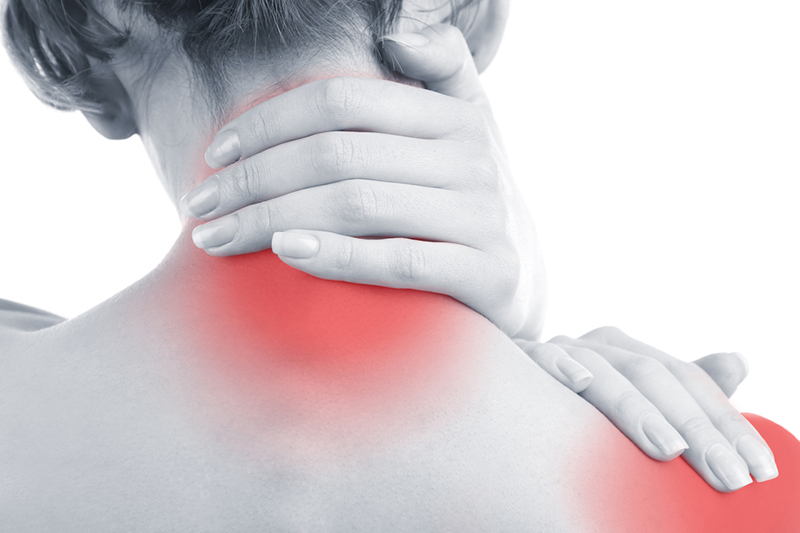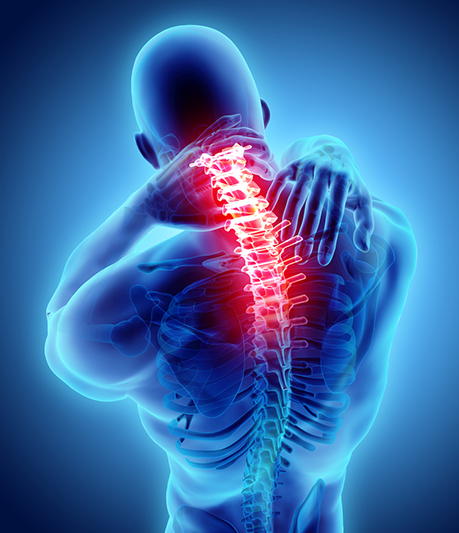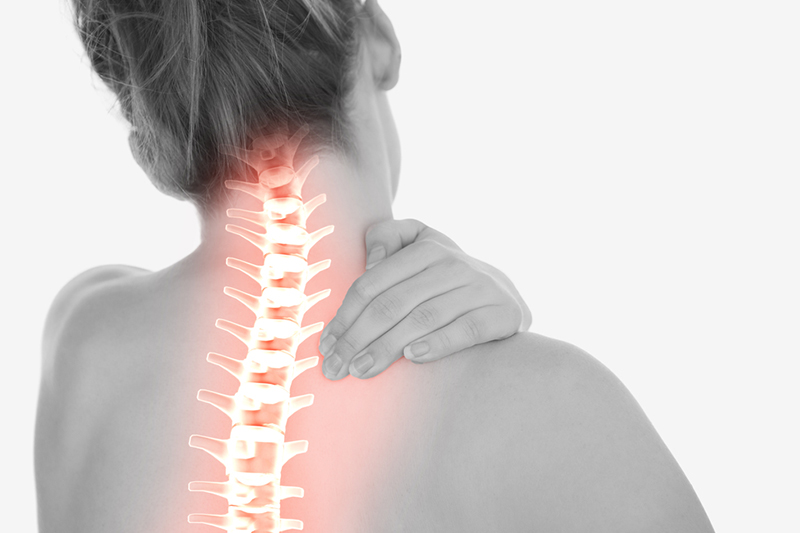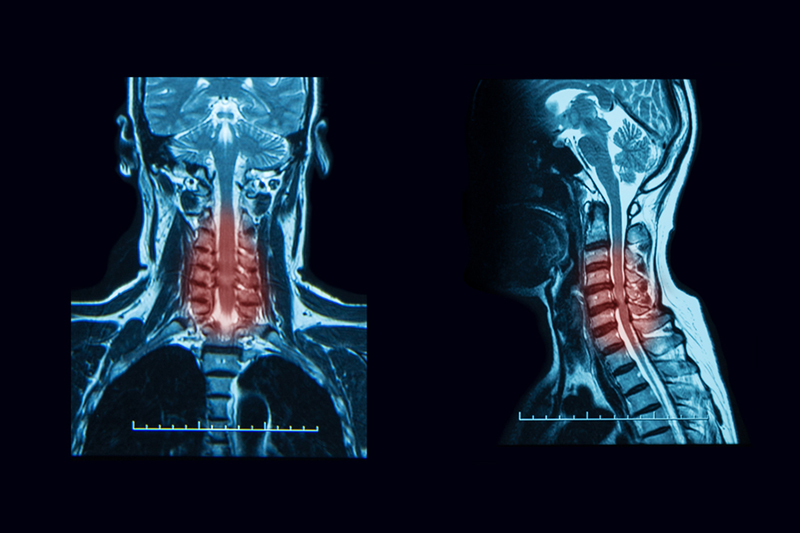Neck Pain in Beverly Hills
Cervical Radiculopathy
What is Cervical Radiculopathy?
Radiculopathy is commonly referred to as sa “pinched nerve” in the spine. When a nerve in the cervical spine (neck) is compressed, it can result in a range of uncomfortable symptoms (neuropathy) in the upper back, shoulders or arms that may include numbness, pain, tingling, and weakness.

Causes of Cervical Radiculopathy
The human spine is typically made up of 33 vertebrae (specialized bones) that protect the spinal cord from trauma or injury. The specific design of these bones allows for the different movements in each part of the spine. The spine is S-shaped to facilitate balance, shock absorption, and flexibility. Moreover, each vertebra is connected to the adjacent one by an intervertebral disc that acts like a joint so that the spine can bend and twist. This intervertebral disc also acts as a shock absorber.
Damage or injury to the intervertebral discs may cause irritation or compression of the nearby nerve roots. Depending on the nerve that is affected, one may experience symptoms in different areas of the arms, upper back or legs.
Some of the conditions that may cause radiculopathy include:
- Disc herniations
- Osteophytes (bone spurs)
- Degenerative disc disease
- Cervical facet arthropathy / Spondylosis (spinal arthritis)
- Spinal tumors
- Compression fractures
- Scoliosis or other bone deformities.
Learn more about Cervical Radiculopathy
Cervical Facet Syndrome (Spondylosis, Facet Arthropathy/Arthritis, Spondylitis, Facet Sprain)

The human spine is made up of vertebrae (bones) that are stacked on top of each other. Each segment is connected in the front by an intervertebral disc and in the back by small facet joints. Damage, irritation, or degeneration of these small facet joints can lead to significant impairments. The painful conditions caused by abnormal function of the facet joints are referred to as facet syndrome.
Causes of Cervical Facet Syndrome
As people age, the facet joints and discs wear out and degenerate, causing changes that interfere with the normal structure and function of the spine. Spine degeneration is a common aging process, and spinal arthritis may not cause major problems. That being said, some people experience severe neck pain from arthritic facet joints. This painful degenerative spinal condition is referred to as spondylosis, facet disease or facet pain.
Facet syndrome can affect the cervical spine (neck), thoracic spine (upper and middle back), or lumbar spine (lower back). As the discs separating vertebrae shrink (with age or trauma), it places greater forces on the facet joints in the back of the spine causing the bones to rub against each other during spinal movement. This contributes to the changes in the structure and function of the joints.
The facet joints can also cause significant pain without any evidence of degeneration. Often times this is due to inflammation of the facet joint (spondylitis) or a facet joint sprain caused by trauma to joint due to rapid movements of the spine that can occur in accidents or sports injuries.
In cases of trauma, the sudden movement from, for example, a whiplash injury from a car accident or football tackle can cause the joints to smash against one another. This may lead to damage and swelling of the facet joints that is often not detected even on advanced imaging.
Symptoms of Cervical Facet Syndrome
- Neck pain
- Neck stiffness
- Pain that radiates to the upper back and shoulders
- Headaches
- Pain with looking upward/twisting motions
Learn more about Cervical Facet Syndrome
Discogenic Neck Pain / Degenerative Disc Disease

The human spine is made up of vertebrae (bones) that are stacked on top of each other. Each segment is connected in the front by an intervertebral disc and in the back by small facet joints. The discs act like shock absorbers in the spine and allow the vertebrae to bend and twist relative to one another. Damage to one or more of these discs can lead to a painful condition referred to as discogenic pain.
Causes of Discogenic Neck Pain and Degenerative Disc Disease
There are various causes of discogenic neck pain, but most commonly it is caused by trauma or degeneration (wear and tear).
In cases of trauma, such as in a car accident or sports injury, there can be damage or inflammation to the outer layers of the disc leading to disc herniations, bulges, extrusion, prolapse etc. This damage and deformation can cause swelling and pain in the neck itself, or cause irritation or compression of a nerve which may result in Cervical Radiculopathy or Cervical Spinal Stenosis.
Often times discogenic pain may be a result of wear and tear, drying out, and shrinking of the disc over time. In that case it is referred to as degenerative disc disease.
As the process is a slow and gradual decline of the integrity of the disc, degenerative disc disease is often not painful in and of itself, but rather can cause other painful conditions due to the change in the structure and function of the spine. The disc can be gradually pushed into the spinal canal causing Cervical Radiculopathy or Cervical Spinal Stenosis. As the discs between the vertebrae shrink, it places greater forces on the facet joints in the back of the spine, causing the bones to rub against each other during spinal movement. This can lead to conditions like Cervical Facet Syndrome and Cervical Spondylosis.
Symptoms of Discogenic Pain
- Neck pain with lifting, bending, twisting, or sitting.
- Relief from pain with certain activities or changing positions
- Pain in the neck, upper back, or shoulders
- Intermittent numbness or tingling in the arms
Learn more about Discogenic Neck Pain
Cervical Spinal Stenosis

Spinal stenosis is a disorder involving the narrowing of the spinal canal. The spinal canal houses the spinal cord and nerve roots, and narrowing of this passage can cause compression and irritation of these structures.
Causes of Cervical Spinal Stenosis
Any condition or disease process that takes up space or causes narrowing of the spinal canal can cause spinal stenosis. Some conditions are present at birth or due to developmental abnormalities and may present earlier in life.
Other causes of spinal stenosis are acquired and are either due to trauma, degeneration (wear and tear), disease, or a combination of these. Some of the contributing conditions may include:
- Compression fractures
- Cervical disc herniation (see Cervical Discogenic Pain or Cervical Radiculopathy)
- Cervical spondylosis with hypertrophy (see Cervical Facet Syndrome)
- Spondylolisthesis (slippage of a vertebrae)
- Ligamentum flavum hypertrophy (Thickening of a ligament in the spine)
- Tumor or neoplasm
Learn more about Cervical Spinal Stenosis


